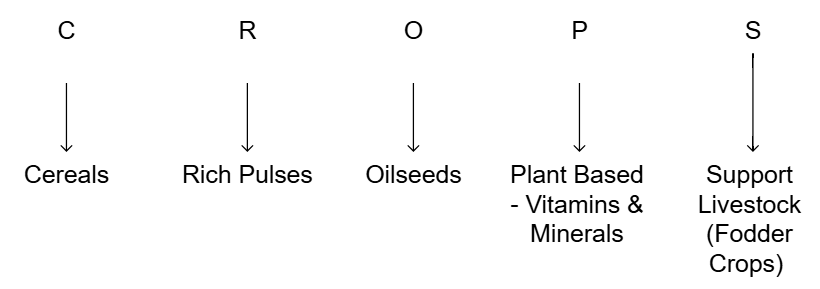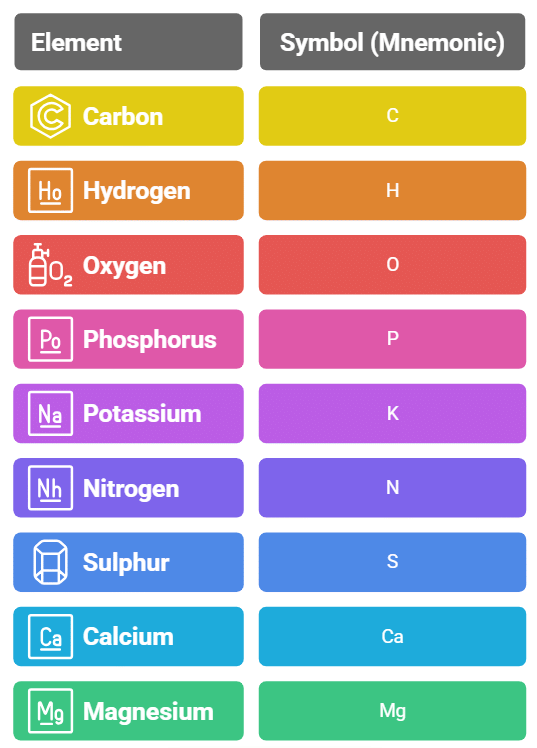Mnemonics: Improvement in Food Resources | Science Class 9 PDF Download
1. Nutritional Benefits of Crops
Mnemonic: CROPS Feed

Mnemonic Explanation:
- Cereals such as wheat, rice, maize, millets, and sorghum provide us with carbohydrates for energy.
- Pulses like gram (chana), pea (matar), black gram (urad), green gram (moong), pigeon pea (arhar), and lentil (masoor) supply us with protein.
- Oilseeds including soybean, groundnut, sesame, castor, mustard, linseed, and sunflower offer essential fats.
- Vegetables, spices, and fruits deliver a variety of vitamins and minerals, along with small amounts of proteins, carbohydrates, and fats.
- Fodder crops like berseem, oats, or Sudan grass are grown for livestock feed.
2. Methods for Crop Variety Improvement
Mnemonic : Hy Gene Bro
- Hy - Hybridisation
- Gene - Genetic Modification
- Bro - Breeding
Mnemonic Explanation
- Hybridisation: This involves crossing genetically different plants, which can be intervarietal (across different varieties), interspecific (between species of the same genus), or intergeneric (across different genera).
- Genetic modification: Adding specific genes to achieve desired traits in crops.
- Breeding for beneficial traits: Choosing varieties with qualities like disease resistance, fertiliser response, product quality, and high yields.
3. The factors for which variety improvement is done are:
Mnemonic = YQR-MAD or Your Quality Rice Makes Amazing Dishes
Mnemonic Explanation
- Higher yield: To increase the productivity of the crop per acre.
- Improved quality: Quality needs vary by crop. For example, baking quality is vital in wheat, protein quality is essential in pulses, oil quality is important in oilseeds, and preservation quality matters for fruits and vegetables.
- Biotic and abiotic resistance: Developing varieties that resist diseases, insects, nematodes, drought, salinity, water logging, heat, cold, and frost. Crop production can suffer due to biotic stresses (like diseases and insects) and abiotic stresses (like drought and salinity). Varieties that can withstand these stresses can enhance crop production.
- Change in maturity duration: Shorter crop duration from sowing to harvesting makes the variety more economical. This allows farmers to grow multiple crops in a year and reduces production costs. Uniform maturity simplifies harvesting and lowers losses during the process.
- Wider adaptability: Developing varieties that can adapt to various environmental conditions helps stabilise crop production. A single variety can then thrive in different climatic regions.
- Desirable agronomic characteristics: Traits like tallness and extensive branching are beneficial for fodder crops, while shorter plants are preferred in cereals to consume fewer nutrients. Thus, developing varieties with these traits boosts productivity.
4. Nutrient Types
(i) Macronutrients
Mnemonic: “CHOPKNS CaMg”

Mnemonic Explanation: These are nutrients required in large amounts, including carbon, oxygen, hydrogen, and others from the soil. (C = Carbon, H = Hydrogen, O = Oxygen, P = Phosphorus, K = Potassium, N = Nitrogen, S = Sulphur, Ca = Calcium, Mg = Magnesium)
(ii) Micronutrients
Mnemonic : "Fun Zoo Cats Bite Many Mice Cleverly"
- Fun → Fe (Iron)
- Zoo → Zn (Zinc)
- Cats → Cu (Copper)
- Bite → B (Boron)
- Many → Mo (Molybdenum)
- Mice → Mn (Manganese)
- Cleverly → Cl (Chlorine)
Mnemonic Explanation: These are needed in smaller quantities and are also supplied by the soil. Examples: (Fe = Iron, Zn = Zinc, Cu = Copper, B = Boron, Mo = Molybdenum, Mn = Manganese, Cl = Chlorine)
5. Nutrient Management
Mnemonic: MANURE-F
- Macro-nutrients – Needed in large amounts (e.g., nitrogen, phosphorus).
- Air & water – Provide carbon, oxygen, and hydrogen.
- Nutrients (13) – Supplied by soil.
- Use manure – Adds organic matter, improves fertility.
- Recycle waste – Compost, vermicompost, green manure.
- Environment-friendly – Reduces chemical fertiliser use.
- Fertilisers – Commercially provide nitrogen, phosphorus, potassium.
Mnemonic Explanation: Captures the role of nutrients, manure types (compost, vermicompost, green manure), and fertilizers in maintaining soil health and boosting crop growth.
6. Irrigation Systems
Mnemonic: WCRT
- Wells – Dug wells, tube wells for water access.
- Canals – Distribute water from reservoirs/rivers.
- River lift – Direct river water for irrigation.
- Tanks – Store runoff; include rainwater harvesting.
Mnemonic Explanation: Lists the main irrigation systems in India, helping students recall the methods used to ensure crops get water.
7. Cropping Patterns
Mnemonic: MIC
- Mixed cropping – Wheat + gram, reduces disease risk.
- Inter-cropping – Soybean + maize, optimizes nutrient use.
- Crop rotation – Different crops in sequence, improves soil health.
Mnemonic Explanation: Simplifies the three main cropping patterns, emphasizing their benefits like risk reduction and nutrient optimization.
8. Crop Protection Management
Mnemonic: WID-P
- Weeds – Compete for resources (e.g., Xanthium, Parthenium).
- Insects – Damage by cutting, sucking, boring.
- Diseases – Caused by bacteria, fungi, viruses.
- Protection – Pesticides, mechanical removal, resistant varieties, crop rotation.
Mnemonic Explanation: Highlights the main threats to crops (weeds, insects, diseases) and methods to protect crops, including preventive measures.
9. Storage of Grains
Mnemonic: CLEAN Store
- Clean produce – Thorough cleaning before storage.
- Low moisture – Proper drying in sun/shade.
- Effective fumigation – Use pest-control chemicals.
- Avoid losses – From biotic (insects, fungi) and abiotic (moisture, temperature) factors.
- Neat warehouses – Systematic management to reduce losses.
Mnemonic Explanation: Focuses on steps to prevent storage losses due to biotic and abiotic factors, emphasizing cleaning, drying, and fumigation.
10. Composite Fish Culture
Mnemonic = CR MG SR

Mnemonic Explanation: In composite fish culture, different fish species are chosen so they do not compete for food. For instance, Catlas feed at the surface, Rohus in the middle, while Mrigals and Common Carps feed at the bottom, and Grass Carps eat weeds. This mix allows for maximal use of food without competition.
11. Bee Species
Mnemonic : Ceri Dori Flori Melli
- Ceri - cerana (Apis cerana indica, Indian bee)
- Dori → dorsata (A. dorsata, Rock bee)
- Flori → florae (A. florae, Little bee)
- Melli → mellifera (A. mellifera, Italian bee)
Mnemonic Explanation:
- Local bee varieties, such as Apis cerana indica (the Indian bee), A. dorsata (the rock bee), and A. florae (the little bee), are used alongside the Italian bee (A. mellifera) for commercial honey production.
- The Italian bees have high honey collection capacity, sting somewhat less, and stay in a given beehive for long periods
|
84 videos|478 docs|60 tests
|
FAQs on Mnemonics: Improvement in Food Resources - Science Class 9
| 1. What are the main methods of improving food resources? |  |
| 2. How does technology contribute to food resource improvement? |  |
| 3. What role do government policies play in food resource management? |  |
| 4. Why is sustainable agriculture important for food resources? |  |
| 5. What are some challenges faced in improving food resources? |  |
















